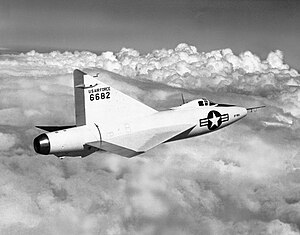Convair XF-92
| XF-92A | |
|---|---|
 |
|
| A photo of the Convair XF-92A in flight | |
| Role | interceptor aircraft |
| Manufacturer | Convair |
| First flight | 1 April 1948 |
| Status | Canceled |
| Primary user | United States Air Force |
| Number built | 1 |
| Unit cost |
US$4.3 million for the program
|
| Variants | Convair F-102 Delta Dagger |
The Convair XF-92 (originally designated XP-92) was an early American delta-wing aircraft. Originally conceived as a point-defense interceptor, the design was later used purely for experimental purposes. However, it led Convair to use the delta-wing on a number of designs, including the F-102 Delta Dagger, F-106 Delta Dart, B-58 Hustler, the US Navy's F2Y Sea Dart as well as the VTOL FY Pogo.
Prior to August 1945, the Vultee Division of Consolidated-Vultee looked at the possibility of a swept-wing aircraft powered by a ducted rocket. Years earlier, the company had performed designs which involved liquid-cooled radiator engines. If properly designed, fuel would be added to the heat produced by small rocket engines, creating a "pseudo-ramjet".
In August 1945, the United States Army Air Forces (USAAF), soon to be renamed the United States Air Force, issued a proposal for a supersonic interceptor capable of 700 mph (1,100 km/h) speeds and reaching an altitude of 50,000 feet (15,000 m) in four minutes. Several companies responded, among which was Consolidated-Vultee, which submitted its design on 13 October 1945. This design featured swept wings and V-tails, as well as a powerful propulsion system. Besides the ducted rocket, four 1,200 pounds-force (5.3 kN) rockets were positioned at the exhaust nozzle, along with the 1,560 pounds-force (6.9 kN) 19XB turbojet produced by Westinghouse.
A proposal by Consolidated Vultee (later Convair) was accepted in May 1946, with a proposal for a ramjet-powered aircraft, with a 45° swept wing under USAAF Air Materiel Command Secret Project MX-813. However, wind tunnel testing demonstrated a number of problems with this design.
...
Wikipedia
